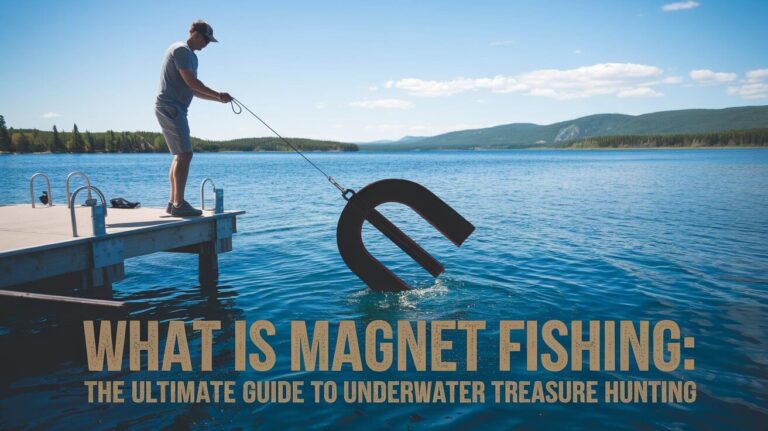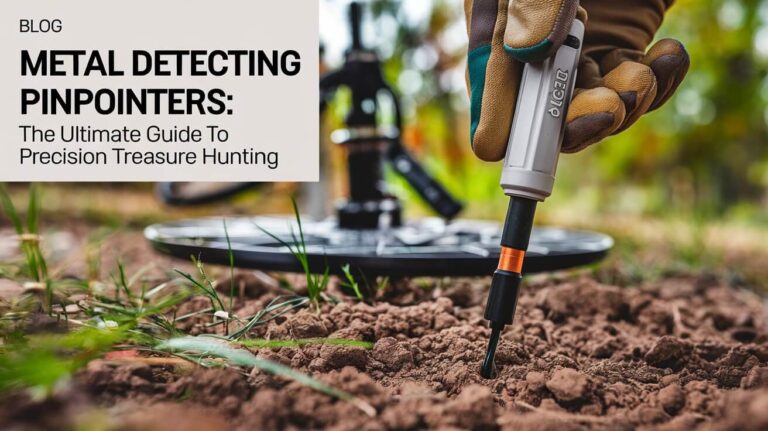
Gold has captivated humans for millennia, driving explorers and fortune-seekers to far-flung corners of the earth. While metal detectors are popular tools for modern prospectors, there are numerous ways to find gold without relying on electronic devices. You can detect gold without a metal detector by using techniques like panning, sluicing, dry washing, and visual identification. This guide explores these methods and more, helping you become a savvy gold prospector.
Understanding Gold Deposits and Formation
To find gold, you need to know where it’s likely to be. Gold forms in specific geological conditions and tends to concentrate in certain areas.
Types of Gold Deposits
Gold occurs in two main types of deposits:
- Lode deposits: Gold embedded in solid rock, often in quartz veins.
- Placer deposits: Gold that’s eroded from its original source and deposited in streams or riverbeds.
Placer deposits are typically easier to find without specialized equipment, making them ideal for beginners.
Geological Indicators of Gold Presence
Look for these signs that might indicate gold:
- Quartz outcroppings
- Iron staining on rocks
- Black sand deposits
- Areas with volcanic or metamorphic rocks
Knowing these indicators boosts your chances of striking gold.
Essential Tools for Non-Electronic Gold Detection
Before heading out, gather the right tools. You don’t need fancy gadgets to find gold.
Gold Pans and Sluice Boxes
Gold pans are simple but effective. They use water and motion to separate gold from lighter materials. Sluice boxes are longer versions that process more material.
Shovels, Picks, and Other Digging Tools
A sturdy shovel and pick are must-haves. They’ll help you dig into promising areas and collect material for panning.
Classifiers and Screens
These tools sort material by size, making the panning process more efficient.
Safety Equipment
Don’t forget safety gear like gloves, sturdy boots, and sun protection. Gold prospecting can be physically demanding, so prepare accordingly.
Visual Identification Techniques
Spotting gold with your eyes takes practice, but it’s a valuable skill for any prospector.
Recognizing Gold in Its Natural State
Gold in nature doesn’t always look like jewelry. It can be:
- Flakes
- Nuggets
- Dust
Learn to spot these forms to improve your chances of success.
Differentiating Gold from Fool’s Gold
Pyrite, or fool’s gold, often tricks beginners. Here’s how to tell them apart:
- Gold is softer and can be scratched with a knife
- Pyrite has sharp edges, while gold is more rounded
- Gold is much heavier than pyrite
Color and Luster Characteristics
True gold has a distinctive color and shine. It’s yellow with a metallic luster, while pyrite is more brassy and can have a greenish tint.
Prospecting in Rivers and Streams
Rivers and streams are hotspots for placer gold deposits. Here’s how to work these areas effectively.
Reading Water Flow and Sediment Patterns
Gold, being heavy, settles in predictable patterns:
- Behind large rocks
- In bends of rivers
- Where water speed changes suddenly
Look for these features to find promising spots.
Identifying Promising Locations for Gold Accumulation
Some key areas to check include:
- Gravel bars
- Bedrock cracks
- Natural sluices formed by the river
These spots often trap gold as it moves downstream.
Panning Techniques for River Gold
To pan effectively:
- Fill your pan with gravel and sand
- Submerge it in water
- Swirl and shake to separate materials
- Tilt the pan to wash away lighter particles
- Look for gold at the bottom of the pan
Practice makes perfect with this technique.
Dry Washing for Gold in Arid Regions
In areas without water, dry washing is an effective gold-finding method.
Principles of Dry Washing
Dry washing uses air instead of water to separate gold. It relies on gold’s high density to sort it from lighter materials.
Choosing the Right Location for Dry Washing
Look for:
- Dry creek beds
- Desert washes
- Areas with exposed bedrock
These spots often contain placer deposits suitable for dry washing.
Step-by-Step Dry Washing Process
- Collect dry material from a promising area
- Sift out large rocks
- Pour material into the dry washer
- Operate the bellows or blower to create airflow
- Collect and pan the concentrates to find gold
This method works well in arid environments where water is scarce.
Sluicing Techniques for Gold Recovery
Sluicing allows you to process more material than panning alone.
Setting Up a Sluice Box
Choose a spot with a steady water flow. Place your sluice box so water runs through it smoothly. Anchor it securely to prevent movement.
Optimal Water Flow and Material Feed
The key is balance. You want enough water to move material through the sluice, but not so much that it washes away gold. Feed material steadily, not overloading the sluice.
Cleaning and Checking Sluice Box Concentrates
Periodically stop and check your sluice. The riffles should trap gold and other heavy minerals. Clean these out and pan the concentrates to recover your gold.
Gold Detection Through Geological Mapping
Maps are valuable tools for finding gold-rich areas.
Understanding Geological Maps
Geological maps show rock types, fault lines, and other features that can indicate gold deposits. Learn to read these maps to guide your prospecting.
Identifying Gold-Bearing Rock Formations
Look for:
- Quartz veins
- Granite intrusions
- Metamorphic rock boundaries
These formations often host gold deposits.
Using Topographical Features to Locate Gold
Topographical maps reveal landscape features that can concentrate gold, such as:
- River bends
- Mountain bases
- Ancient river channels
Use these maps to plan your prospecting trips more effectively.
Chemical Tests for Gold Identification
Sometimes, you need more than visual inspection to confirm gold.
Simple Field Tests for Gold
Try these quick tests in the field:
- Streak test: Gold leaves a yellow streak on unglazed porcelain
- Acid test: Gold doesn’t react with nitric acid
These can help you quickly assess potential finds.
Professional Assaying Methods
For more accurate results, consider professional assaying. This involves lab testing to determine gold content precisely.
Interpreting Test Results
Understanding test results helps you assess the value of your finds and guides future prospecting efforts.
Traditional and Cultural Methods of Gold Detection
Some unconventional methods have been used to find gold throughout history.
Dowsing and Other Folk Techniques
Dowsing, using a forked stick or pendulum to locate gold, lacks scientific backing but remains popular among some prospectors.
Indigenous Knowledge in Gold Prospecting
Many indigenous cultures have traditional gold-finding methods. While not always scientifically proven, these techniques often stem from deep knowledge of local geology and landscapes.
Environmental Considerations in Gold Prospecting
Responsible prospecting is crucial for preserving nature and maintaining access to prospecting areas.
Minimizing Environmental Impact
Follow these guidelines:
- Refill any holes you dig
- Don’t disturb vegetation unnecessarily
- Avoid polluting water sources
Leave the area as you found it, or better.
Legal and Ethical Aspects of Gold Prospecting
Be aware of:
- Land ownership and access rights
- Required permits
- Protected areas where prospecting is prohibited
Always prospect legally and ethically.
Common Mistakes to Avoid When Detecting Gold Without a Metal Detector
Learning from others’ errors can save you time and frustration.
Overestimating Gold Abundance
Gold is rare. Don’t expect to find nuggets everywhere. Patience and persistence are key.
Neglecting Research and Preparation
Do your homework before heading out. Research promising areas and learn about local geology.
Ignoring Safety Precautions
Prospecting can be dangerous. Always tell someone where you’re going, bring adequate supplies, and be prepared for emergencies.
Enhancing Your Gold Detection Skills
Continuous learning improves your chances of success.
Learning from Experienced Prospectors
Seek out mentors or join prospecting groups. Experienced prospectors can share valuable insights and techniques.
Joining Gold Prospecting Clubs and Communities
These groups offer:
- Access to claims
- Shared equipment
- Educational opportunities
They’re great resources for beginners and experienced prospectors alike.
Continuous Education and Skill Development
Keep learning about geology, prospecting techniques, and local gold deposits. The more you know, the better your chances of finding gold.
Conclusion
Detecting gold without a metal detector is an art that combines knowledge, skill, and a bit of luck. By understanding gold formations, mastering various prospecting techniques, and continuously honing your skills, you can increase your chances of finding this precious metal. Remember, successful gold prospecting requires patience, persistence, and respect for the environment. Whether you’re drawn by the thrill of discovery or the potential for profit, the techniques outlined in this guide provide a solid foundation for your gold-seeking adventures. Happy prospecting!






